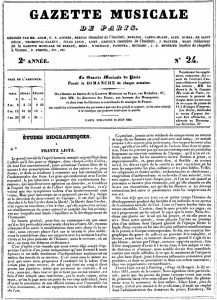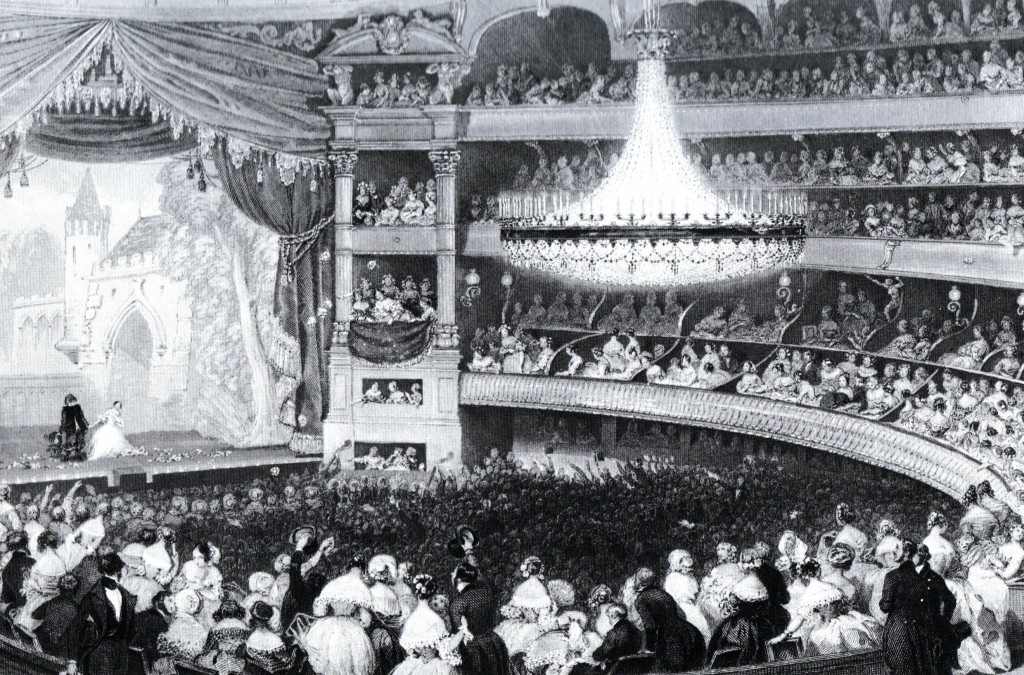Liszt’s Depression
Liszt’s biographers are in agreement over the fact that it was Caroline’s father who put an end to their relationship. After the death of Caroline’s mother, Liszt’s piano lessons sometimes extended well beyond the normal hours into the evening. This did not go unnoticed by the staff and certainly was not acceptable behaviour in those days, so they informed the count. It must have been crystal clear for “petit Liszt” that he was not an eligible candidate for Countess Caroline de Saint-Cricq[1]. Rather than blaming the count for the break-up of his romance, Liszt projected it onto himself, thereby sinking further into a depression that had started at the death of his father in summer 1827.
To Carolyne Sayn-Wittgenstein he wrote in March 1854[2]: “Her father had done us both a lot of harm, with the most reasonable intentions in the world. I never wished him harm in return, and some six years later I more or less forgave him”. It was six years later, in 1833, when Liszt began his long relationship with Countess Marie D’Agoult.
Joseph D’Ortigue, “Études Biographiques: Frantz Listz”, Gazette Musicale, 1835
Joseph d’Ortigue was the first who publicly wrote about Liszt’s love affair with Caroline. Shortly after he obtained Liszt’s diary notes via his mother (in 1834) he wrote the following in his article in La Gazette Musicale[3] in June 1835. It is the closest and probably most accurate account of this period in Liszt’s life:
“It is at this point in time that his first grand introduction to life through feelings of love took place and, subsequently, by feelings of suffering and expiation. We do not consider it our mission to inform about this period of crises; we consider it enough to provide the following observation as a kind of morality that emerges from this event which we prefer not to mention: The aristocracy admires talent; it pursues it, encourages it, applauds it, and rewards it. But if it rewards it, it is done because it considers a talent as something that one can pay for with money. A nobleman will never give his daughter to an artist; he will say that such a lowering of status has never happened in his family, or, if it has, he would not want to repeat such a scandal.”
In any case the effects of Liszt’s disastrous love affair were not diminished, the deepest part of his depression lasting from August to December 1828. During these months, apart from his daily lessons to students from the aristocracy, he focused on religious aspects and read literature that Caroline introduced to him.
This period is described by some as a typical example of a Mal de René (aka Mal du Siècle) after the short novella René (published April 14, 1802) written by Francois-René de Chateaubriand[4].
René was at the very top of Liszt’s reading list and had, according to Joseph d’Ortigue[5], been Liszt’s only reading book for six months and had “wrung tears from him incessantly”. It had a fundamental impact on his personality and set the tone for his response to the depression. Liszt must have seen many parallels between the novel René and his own situation: the sudden death of his father, the loneliness, the need to look after himself, his desire to get away from his organized child-prodigy concert life, and last but not least his forbidden love for the angelic Caroline, had all contributed to his depression. In his testament-letter[6] from 1860 he wrote to Princess Carolyne Sayn-Wittgenstein that during his seventeenth year “I implored with humility and tears that I might be permitted to enter the Paris Seminary” (note that Liszt was still sixteen years at the time — Caroline was one year older). His mother Anna managed to talk him out of this, for which we should be thankful.
In his depressed state of mind, Liszt eschewed public appearances. Some thought that he had passed away, and an obituary notice “Death of Young Liszt” appeared on Thursday October 23, 1828 in the weekly boulevard magazine Le Corsaire[7]. The notice was well written and can both be interpreted as an obituary notice but also as an announcement of the end of Liszt’s days as a child prodigy. The lyrical form of the notice makes one wonder if one of Liszt’s fellow-composers, admirers and, later, best friend Hector Berlioz may have had a hand in it: Berlioz started writing music reviews for Le Corsaire in the year 1823.
From the personal records of Wilhelm Von Lenz[8] who, on impulse, decided to contact Liszt in late November 1828 after seeing theatre-billboards on the streets announcing a Liszt recital, we can conclude that Liszt was on his way to recovery by this time. Following his first meeting with Von Lenz, Liszt enthusiastically welcomed musical scores of various pieces by the composer Carl Maria von Weber and accepted Von Lenz as his first Master student. Liszt planned to start performing in public again with a recital on December 25th, but had to cancel because of a measles infection. In his letter[9] to Carl Czerny on December 23, 1828, Liszt mentioned he had been ill and therefore unable to perform Czerny’s compositions but stated that he was eager to play again. He cunningly suggested a possible business deal by offering to promote Czerny’s works for a fee. That same day, Liszt wrote a short letter to his client M. De Mancy[10] to cancel an appointment for a wedding event, stating that he had so many students that he could only play after ten o’clock in the evening. His letter to Madame Eders[11] in Rouen on January 8, 1829, was optimistic about a future visit and showed that Liszt was very busy with his teaching in those days and his aspirations to start composing.
We know that Liszt participated in several concerts early 1929 as well as in private concerts organized by Gioacchino Rossini, the head of the Italian Theatre in Paris. During these concerts he may have picked up snippets of Rossini’s Guillaume Tell[12] opera that had its premiere on August 3, 1929. His piano transcription and variations on Guillaume Tell became one of his favourite bravura pieces in later years. Liszt started to compose and focus on his artistic side from early 1829 onwards.
Salle Ventadour (opened in 1829 as Opéra-Comique, after 1838: Théâtre-Italian) (ca. 1840)
In April 1829 he first performed his Grand fantaisie sur la Tyrolienne de l’opera ‘La fiancé’ d’Auber[13] (Auber’s original opera had its première in January that year). On May 5, at one of the salon events[14], he met Victor Hugo, Prospèr de Mérimée, Victor Pavie and probably also Sainte-Beuve and soon after became friends with Lamartine, De Vigny and Alfred De Musset.
Liszt’s biographer Guy de Pourtalès stated that the depression lasted eighteen months. If we consider the death of Liszt’s father (August 1827) as starting point for the depression, which further deepened and becoming noticeable to the outside world after the break-up with Caroline it would add up to this eighteen month period.
Liszt provided us with his own clue for his depression in his letter to George Sand in Revue et Gazette Musicale[15] in January 1837.
“Thenceforth a premature melancholy weighed upon me, and I submitted with an instinctive sense of repulsion to the thinly disguised degradation of being an artistic servant [ …] In those years, I was struck by a malaise that lasted for two years, following which my compelling need for faith and self-sacrifice, not having any other outlet, was given entirely over to the austere practices of Catholicism. My fevered brow bent low over the damp flagstones in the church of Saint Vincent de Paul[16]; I drained my heart and subjugated my thoughts. An image of a woman, chaste and pure as the alabaster of sacred vessels, was the sacramental bread I tearfully offered to the Christian God. The renunciation of all earthly things was the sole activator, the only watchword of my life” [ … ] “But such a total isolation could not last forever. Poverty, that old intermediary between man and misfortune, wrested me from my contemplative solitude and often sent me back to appear before the public, upon whom my existence and that of my mother partly depended. ”
Eventually, Liszt’s depressive phase became general knowledge and formed a standard part of his biography published by newspapers announcing his performances, such as the one for his concert series in Bordeaux and Pau[17] in 1844:
“A great passion for a young girl, who he couldn’t marry because of his highly delicate feelings of reluctance on moral grounds, was the cause for a great sickness of which he nearly succumbed at the time.”
It must have been an emotional moment for Caroline when she read this in her local newspaper one week before Liszt’s arrival in October 1844. No one else in Pau knew that this young girl had become the “Maîtresse de Salon Dartigaux”.
From the perspective of the outside world, Liszt’s depression took about six months. He picked up his life again by the end of 1828, although he will have carried the pain within him for a much longer time, as is common after such dramatic events. Liszt’s emergence from his depression was stimulated by the literature that he read, ignited by his beloved Caroline and his confessor Bardin[16]. Older and much wiser, Liszt now touched and tried everything that interested him.
In 1830, the year of the July revolution, he appeared to have fully recovered and regularly attended gatherings of the art community: “réunions d’artistes”. There, he shared and obtained inspiration on cultural, philosophic, and religious aspects and became attracted to the Saint-Simonian[18] social and religious approach.
That same year, on December 4, 1830, Liszt befriended the romantic bohemian, and atheist, Hector Berlioz[19]. Beside their close musical interaction, Berlioz introduced Liszt to Goethe’s works, and specifically to Faust. The following year, when Caroline married Bertrand Dartigaux in Paris, Liszt met with Chopin, Hiller, and Mendelssohn. From that point onwards Liszt was in the company of friends who knew how to live the good life. He quickly became a key member of the Parisian cultural society and a public figure who knew every artist and aristocratic person of any importance, and vice versa.
He was only nineteen years old.
Next: Liszt and Jasmin
[1][↑] After this romance break-up for reasons of nobility, Caroline lost her title as countess because she married a commoner, while the humble piano player Liszt had France to his feet, with a distinguished aristocratic walk and manners that made people treat him like royalty.
[2][↑] La Mara, Lettres de Franz Liszt a la Princesse Carolyne Sayn-Wittgenstein, Paris, Breitkopf & Härtel, 1900, L. 140, p. 184.
[3][↑] Joseph D’Ortigue, “Études Biographiques: Frantz Listz [sic]”, Gazette Musicale de Paris, Deuxième Année, No. 24, June 14, 1835 (Original scanned by Google)(transcript by University of London).
[4][↑] The short novel René (with substitle ou Les Effets des passions) tells about a young man who, after his father’s death, travels the world and finds his idealized country corrupt and irreligious upon his return. Disgusted, he plans to kill himself but is saved by his sister. What follows is a forbidden desire between the romantic young nobleman and his sister. Her decision to overcome this unacceptable feeling is to become a nun. This caused René to sink into a permanent state of pessimism, melancholy, apathy, and general distaste for living. Nothing could ever reinstate the happy days of his youth. These feelings were described and analysed by Chateaubriand in great detail. René, published in 1802, was an instant hit in turbulent Paris after the Revolution and the turn of the 19th century. Its description of René being alienated from the present world and his disillusion all related to the start of the new century, which brought gas light, steam engines and cultural changes into a hitherto fairly stable (feudal) world. It was the author Sainte-Beuve who first described this melancholic mood as Mal de René (the preface of René’s 2nd edition was written by Sainte-Beuve in 1833, George Sand wrote the preface to the 3rd edition in 1840).
[5][↑] Liszt also read other works that were inspired by René such as Obermann, written in 1804 by Etienne de Sénancour, and which Liszt incorporated in 1835 into his first version of his Vallée d’Obermann composition (which he based on a forest near Fontainebleau – see op. cit. 59, Letter 185, Sep. 4, 1855, p. 258).
[6][↑] La Mara, Briefe de Franz Liszt, Von Paris bis Rom, Leipzig, Breitkopf & Härtel, 1893 letter 240.
[7][↑] The obituary notice has been reprinted in many biographies e.g. : Alan Walker, Franz Liszt, The Virtuoso Years 1811-1847, Cornell University press, 1983, p. 134.
[8][↑] W. Von Lenz, Great Piano Virtuosos of our Time, (from German), Schirmer, New York, 1888, p. 6 (originally published in Neue Berliner Musikzeitung, 1868).
[11][↑] Franz Liszt, Letters in Library of Congress, ed. Michael Short, 2002, Letter 1, p. 1.
[12][↑] Emanuele Senici, The Cambridge companion to Rossini, Cambridge University Press, 2004, p. 175.
[13][↑] Günther Protzies, Studien zur Biographie Franz Liszts und zu ausgewählten seiner Klavierwerke in der Zeit der Jahre 1828 – 1846, Dissertation Fakultät für Geschichtswissenschaft an der Ruhr-Universität Bochum, Summer 2004, p. 14.
[14][↑] Thérèse Marix-Spire, Les Romantiques et La Musique: Le cas George Sand, Paris, Nouvelle Editions Latines, 1954, p. 423.
[15][↑] Liszt, “A un Poete Voyageur, Lettres d’un Bachelier Ès-Musique”, Revue et Gazette Musicale de Paris, February 12, 1837, p. 53 (see also Franz Liszt, Pages Romantiques, with introduction and notes by Jean Chantavoine, Alcan, Paris, 1912, p. 103.
[16][↑] The church of Saint Vincent de Paul at rue de Lafayette as we know it today was under construction from 1824 and opened to the public only in 1844. The church referred to by Liszt was a small chapel with the same name opposite Liszt’s home at rue Montholon. Key person in this part of Liszt’s life was his confessor, abbé Jean-Baptiste Bardin. Besides confessor of Liszt (and, later, of Chopin), Bardin was a bibliophile, linguist, and excellent musician who regularly held musical evenings at his small salon at Rue Montholon. His influence on Liszt and his role in guiding Liszt to normal life in 1828 must have been significant.
[17][↑] Mémorial des Pyrénées, 30e année, Oct. 3, 1844, p. 3.
[18][↑] Ralph P. Locke, Music, Musicians, and the Saint-Simonians, University of Chicago Press, 1986, p. 101.
[19][↑] Hector Berlioz, Memoires 1803 – 1865, Paris, Levy, 1870, p. 168.


